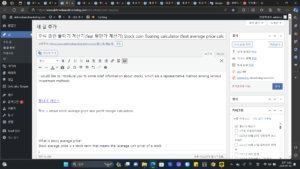I would like to introduce you to some brief information about stocks, which are a representative method among various investment methods.

This is about stock average price and profit margin calculation.
What is stock average price?
Stock average price is a stock term that means the ‘average unit price’ of a stock.
This refers to the average amount (unit price) paid when purchasing stocks of a company based on the market price at the time.
Stock Calculator, Average Price Calculator, Liquidation Calculator Guide
Calculate stock average price
To put it simply, as an example, if you purchased 100 shares of company A for 10,000 won,
At this time, the average unit price is ‘10,000 (total purchase amount) / 100 (total quantity)’, which is 100 won divided by 10000.
Total purchase amount = Market price * Quantity of stocks
Average unit price = total purchase amount / total number of shares
(When trading stocks, information such as average unit price and rate of return can be automatically calculated and the results can be viewed through the securities company app or HTS.)
One important thing here is that you may not always purchase Company A’s stocks at the same price.
You can buy it when the market price is 100 won, or when it rises, you can buy it at 110 won, and when it falls, you can buy it at 90 won.
We will guide you through purchasing the same company’s stocks at a different price than the initial purchase price.
What is stock trading?
As mentioned earlier, in the stock market, stock prices rise and fall repeatedly.
Stock Calculator, Average Price Calculator, Liquidation Calculator Guide
stock market
Stock buying means that when the current price of a stock you own has fallen, you purchase additional stock at a lower price.
This means lowering the average unit price of currently owned stocks through additional purchases.
For example, if a stock purchased for 1 share at 100 won is currently priced at 50 won, the average unit price is 100 won and the current rate of return is -50%.
At this time, if you purchase one more 50 won share, the average unit price becomes ‘(100+50) / 2’, which becomes 75 won, and the rate of return rises to -33%.
In this way, additional shares are purchased at a lower amount than the existing purchase amount,
Lowering the average unit price and increasing returns is called stock riding.
stock burning
There is also a term called ‘stock burning’ as an opposite concept to stock riding.
This refers to buying more when the stock price is rising, as opposed to buying when the stock price is falling.
Of course, since additional purchases are made at a higher price than the existing purchase price, the rate of return will decrease.
As the price of the stock continues to rise, the total profit amount itself gradually increases.
Stock Calculator, Average Price Calculator, Liquidation Calculator Guide
stock price calculator
You can easily calculate stock dividends yourself if the number of stocks or amount is small, but
As the amount or quantity increases, direct calculations can become increasingly difficult, so calculators exist to help with easy calculations.
You can use the calculator by clicking the ‘Go to Jushin Water Calculator’ button below, so please refer to it when necessary.
Go to the stock divestment calculator
Stock Investment Calculator – Stock Investment Calculator
It is a free online calculator that allows you to predict the cost required to lower the unit price of stocks and the change in unit price after the divestment.
www.fntec.net
All investment decisions and responsibilities rest with you…
‘Will you catch the falling blade..?’
The method of riding or burning stocks, which I explained earlier, is just one of many strategies that can be used in stocks.
Rather, a quick stop loss when falling or a quick profit when rising can be helpful for profits.
Therefore, before investing in stocks, learn various investment strategies, refer to the opinions of experts, and
We hope that you can invest based on calm judgment and achieve the good results you want.